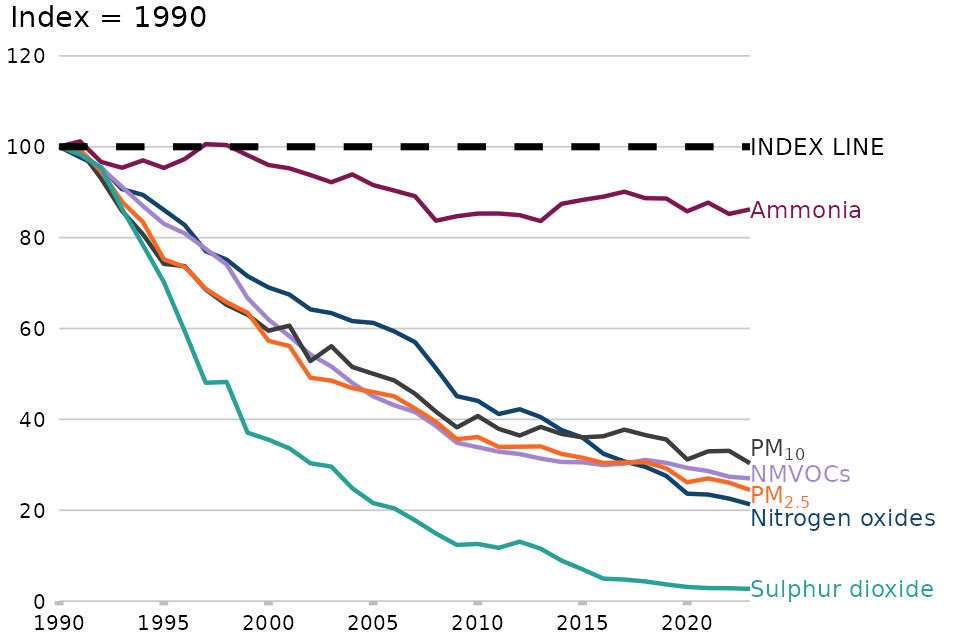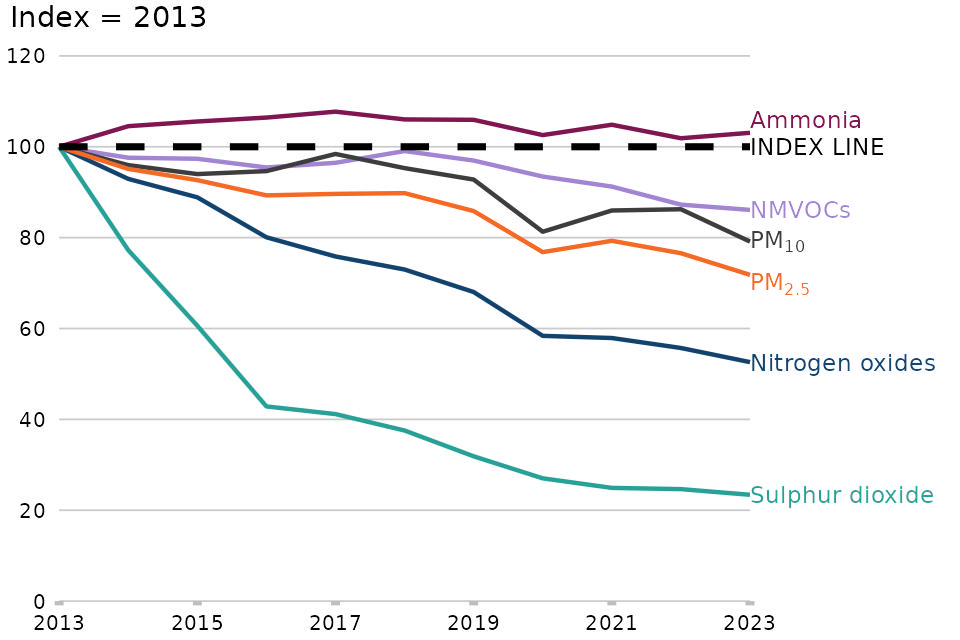Emissions of air pollutants in the UK - Summary
Updated 13 March 2025
This data was revised on March 13th 2025 to apply the latest, improved domestic combustion methodology across all sources. This correction has impacted domestic combustion emissions across the time series causing a substantial reduction to sulphur dioxide emissions and a minor increase to NMVOC emissions.
1. Emissions of air pollutants in the UK - Summary
This section provides an overview of the information in the full publication. It contains statistics on annual emissions of six air pollutants which are key to air quality from 1990 to 2023. The data comes from the National Atmospheric Emissions Inventory which estimates emissions using internationally agreed methods and a wide range of survey and administrative data sources, from both inside and outside of government.
The full publication is available here: Emissions of air pollutants in the UK.
Information on levels and trends in emissions of specific pollutants are available from the following links:
Emissions of particulate matter (PM10 and PM2.5)
Emissions of non-methane volatile organic compounds
National emissions totals are disaggregated by source (see Methods Document) in the accompanying tables. More detailed emissions totals are available on the NAEI website (see Pivot Table viewer) each year in the summer. Emissions maps and emission totals for each of the four administrations of the UK (England, Scotland, Wales, Northern Ireland) are published in the autumn.
2. Contact
Please email us with your feedback to help us make the publication more valuable to you.
Enquiries to: AQIE.Correspondence@defra.gov.uk
Lead analyst: Neil Ward
Production team: Alex Mouatt, Jen Cottingham, Joseph Grealy, Mohamed Ghalaieny, Letizia Pondini, Alison Davies.
You can also contact us via X (formerly Twitter): @DefraStats
3. Long-term trends in emissions of air pollutants
Figure 1: Trends in annual emissions of particulate matter (PM10 and PM2.5), nitrogen oxides, ammonia, non-methane volatile organic compounds (NMVOCs), and sulphur dioxide in the UK: 1990 – 2023

Notes:
- The index line shows the level of annual emissions if they had remained constant at 1990 levels.
- The values of the y-axis represent the percentage of 1990 levels.
Download the data for this chart in CSV format
There has been a long-term decrease in estimated emissions of all of the air pollutants covered by this statistical release (ammonia, nitrogen oxides, non-methane volatile organic compounds, particulate matter (PM10, PM2.5) and sulphur dioxide). Estimated emissions of ammonia increased from 2022 to 2023, while estimated emissions of nitrogen oxides, non-methane volatile organic compounds, PM10, PM2.5 and sulphur dioxide fell from 2022 to 2023.
Many factors are responsible for the long-term decrease in emissions of air pollutants:
-
The reduction in the use of coal for domestic heating and power generation has been a major factor in reducing emissions of particulate matter.
-
The change from using coal to gas for power generation and fitting flue gas desulphurisation equipment to existing coal-fired power stations has been responsible for long-term decreases in emissions of sulphur dioxide and nitrogen oxides.
-
Stricter emissions regulation for road transport has led to emissions reductions for nitrogen oxides, NMVOCs and ammonia.
-
Stricter emissions limits placed on industry have reduced emissions from solvents, which particularly affects emissions of NMVOCs.
4. Emission Reduction Commitments
The UK has commitments to reduce annual emissions of 5 air pollutants by a percentage of 2005 levels, set in the National Emissions Ceilings Regulations (2018). These are known as emission reduction commitments (ERC), shown in the table below. The UK has met the current domestic and international emission reduction commitments for emissions of ammonia, nitrogen oxides, NMVOCs, PM2.5 and sulphur dioxide. The UK has met the emission reduction commitment for ammonia with the inclusion of an approved adjustment. The UK does not have emission reduction commitments for PM10. For more information on the ERCs and ammonia adjustment please see the Background section of this publication.
The table below provides information on the commitments and the compliance status for each pollutant.
| Pollutant | 2005 Emissions | 2023 Emissions | 2020-2029 ERC - (%) | % Reduction Acheived (%) | Compliance Status |
|---|---|---|---|---|---|
| Ammonia | 281 | 249 | 8 | 11 | Compliant |
| NMVOC | 1144 | 628 | 32 | 45 | Compliant |
| Nitrogen oxides (as NO2) | 1701 | 578 | 55 | 66 | Compliant |
| PM2.5 | 105 | 56 | 30 | 47 | Compliant |
| Sulphur dioxide | 760 | 95 | 59 | 87 | Compliant |
Notes:
-
2020-2029 ERC (%) refers to the percentage reduction from 2005 levels that must be met and maintained between the years 2020 and 2029. There is a 2030 emission reduction commitment too, please see here for more details.
-
Ammonia emissions exclude non-manure digestate spreading as detailed in the Background section.
-
The NECR commitments for NMVOCs and nitrogen oxides exclude emissions from agricultural soils and manure management.
5. Recent trends in emissions of air pollutants
Figure 2: Trends in annual emissions of particulate matter (PM10 and PM2.5), nitrogen oxides, ammonia, non-methane volatile organic compounds (NMVOCs), and sulphur dioxide in the UK: 2013 – 2023

Notes:
-
The index line shows the level of annual emissions if they had remained constant at 2013 levels.
-
The values of the y-axis represent the percentage of 2013 levels.
Download the data for this chart in CSV format
In the most recent ten-year period of emissions estimates, there has been mixed progress in reducing emissions of air pollutants:
-
Emissions of sulphur dioxide and nitrogen oxides have continued to fall in line with the long-term trend with much of the reduction as a result of the decreasing dependence on coal for power generation, although the rate of change has lessened in recent years. Emissions of sulphur dioxide and nitrogen oxides from combustion in energy industries decreased by 87 per cent and 67 per cent respectively between 2013 and 2023.
-
Emissions of nitrogen oxides and NMVOCs from road transport decreased by 51 per cent and 57 per cent respectively between 2013 and 2023. This is largely the result of tighter emissions standards being introduced for petrol and diesel cars, and the uptake of electric vehicles.
-
Between 2013 and 2023, total annual emissions of PM2.5 and PM10 decreased by 28 per cent and 21 per cent respectively. This was largely due to a reduction in emissions from combustion of coal in both industrial and non-industrial settings, as well as reduced exhaust emissions from road transport. Emissions of particulate matter from the burning of biomass-based fuels have increased over this period.
-
Total annual emissions of NMVOCs have decreased by 14 per cent between 2013 and 2023, however the sources of these emissions are changing. Emissions from food and beverages production have increased by 26 per cent, whereas fugitive emissions from energy industries (for example pipeline leaks and gas flaring from oil production) have decreased by 39 per cent, and emissions from coating applications (such as specialist finishes applied to vehicles, wood, metal and plastic products) have decreased by 39 per cent.
-
Annual emissions of ammonia have remained fairly steady between 2013 and 2023, with some reduced emissions from activities like road transport (decreased by 39 per cent) and increased emissions from other sources, such as inorganic fertilisers (increased by 4 per cent), non-manure digestate spreading (increased by 143 per cent), dairy cows (increased by 12 per cent) and non-agricultural animals (increased by 29 per cent).
6. Notable sources of emissions of air pollutants in 2023
Emissions of particulate matter originate from a wide range of activity sources, with no single activity dominating. Domestic combustion contributed 20 per cent of total PM2.5 emissions and 10 per cent of total PM10 emissions in 2023. Non-exhaust emissions from road transport (that is road wear, brake wear and tyre wear) represent 17 per cent of total PM2.5 emissions and 16 per cent of total PM10 emissions in 2023. Industrial combustion contributed 10 per cent of total PM2.5 emissions and 5 per cent of total PM10 emissions in 2023. This refers to the combustion of fuels on manufacturing and construction sites to generate energy for industrial use, not to combustion in energy industries, which contributed 3 per cent of total PM2.5 emissions and 2 per cent of total PM10 emissions in 2023. Emissions from construction activity represents 22 percent of total PM10 emissions and 4 per cent of total PM2.5 emissions in 2023; within which, most emissions come from the construction of roads and non-residential buildings. Quarrying activity contributed 7 per cent of total PM10 and 1 per cent of total PM2.5 emissions in 2023.
Transport is a major source of emissions of nitrogen oxides. Road transport contributed 30 per cent of emissions of nitrogen oxides in 2023 and other forms of transport (e.g. aviation, rail, and shipping) contributed 16 per cent.
The combustion of fuels in energy industries were still major sources of emissions of sulphur dioxide (contributed 30 per cent) and nitrogen oxides (contributed 19 per cent) in 2023. However, annual emissions from this source have decreased rapidly in recent years as the UK has moved away from using coal for energy production.
Levels and trends in emissions of ammonia are largely driven by activity in the agricultural sector, primarily linked to herd sizes and the extent of fertiliser spreading. This sector contributed 87 per cent of emissions of ammonia in 2023. Other notable sources of ammonia emissions in 2023 are non-agricultural animals (e.g. domestic pets and horses) (contributed 6 per cent) and the waste sector (contributed 3 per cent).
There are many sources of emissions of NMVOCs. Domestic use of solvents (often found in household products such as cleaners, aerosols and cosmetics) contributed 23 per cent to total emissions of NMVOCs in 2023. Emissions from the production of food and beverages have also increased recently and contributed 16 per cent of total emissions in 2023. Emissions from industrial solvent use and chemicals manufacture are still considerable sources of emissions but these have reduced substantially in the long-term.
Levels and trends in emissions from specific sources are available for the period from 1990 to 2023 through the statistical tables that accompany this release.
Sections in this release
Emissions of particulate matter (PM10 and PM2.5)
Emissions of non-methane volatile organic compounds
Methods and quality processes for UK air pollutant emissions statistics (PDF)
